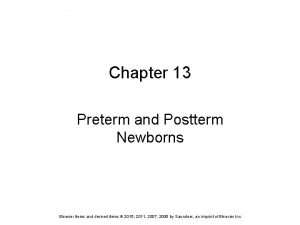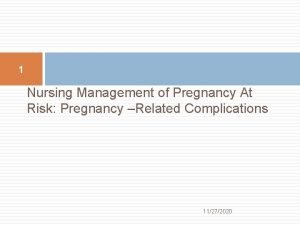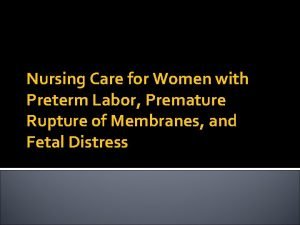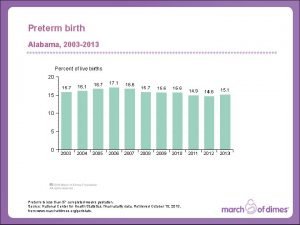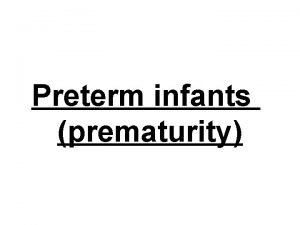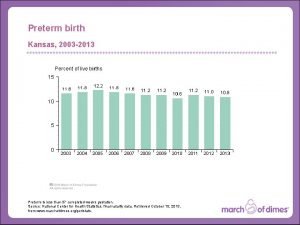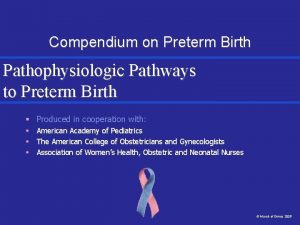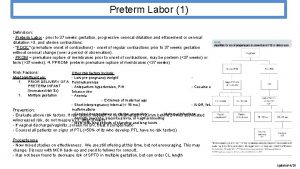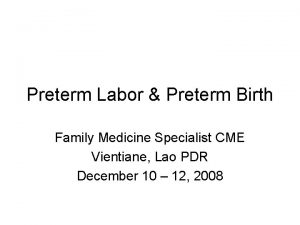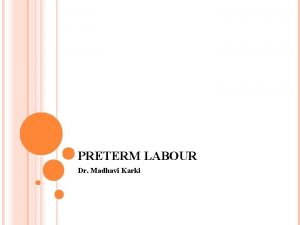PRETERM ADMISSIONS IN LUTH AN OVERVIEW Dr Iretiola















- Slides: 15

PRETERM ADMISSIONS IN LUTH: AN OVERVIEW Dr Iretiola Fajolu Consultant Paeditrician/Senior Lecturer LUTH/CMUL

FACILITY OVERVIEW (1) Lagos University Teaching Hospital is a tertiary referral center It has an O& G department with ANC facilities, a labour ward with 14 suites and 2 operating theatres. There are 2 postnatal wards where stable babies are nursed by the sides of their mothers Babies are usually discharged after 48 hrs from the postnatal wards There is also facility for assisted conception currently in the hospital. The Neonatal unit with two wards - INBORN ward adjoining the labour ward (for babies born in LUTH) and the OUTBORN ward (for babies born outside LUTH and referred for further care)

FACILITY OVERVIEW (2) Inborn ward admission capacity – 40 with 21 incubators and 1 transport incubator Outborn ward admission capacity – 40 with 15 incubators and 1 transport incubator The Neonatology unit staff strength: 4 consultant Neonatologists � 10 Resident doctors � 26 Nurses � 8 support staff � During call hours, there is a consultant on call; with 2 senior and 2 junior registrars and 2 -3 house officers, sleeping in with a minimum of 6 nurses and 1 or 2 supportive staff.

FACILITY OVERVIEW (3) There is a children emergency center where babies admitted from outside are initially stabilized before admission or discharge as required The unit also has access to a pharmacy, microbiology and clinical chemistry laboratory, radiology (X-rays, ultrasound scans, CT scan, MRI), surgical, blood bank, social welfare and pathology services within the hospital. Discharged babies are followed up in the outpatient clinic till 2 years of life

FACILITY OVERVIEW - LUTH Annual delivery rate - 2400 babies Monthly admission rate – 70 -80 babies Monthly referral rate - 150 neonates

SOME DEFINITIONS Preterm – Born before 37 completed weeks of gestation Extreme preterm = <28 weeks gestation Early preterm = 28 -31 weeks gestation Moderate preterm = 32 -33 weeks gestation Late preterm = 34 -36 weeks gestation LBW = 1500 to <2500 g VLBW = 1000 to <1500 g ELBW = <1000 g

PRETERM ADMISSION STATISTICS IN THE LAST ONE YEAR AT LUTH Over the one year period we admitted 1057 neonates into the neonatal wards of LUTH 401 were preterm babies (37. 9%) Preterm discharges – 117 (70. 1%) Total mortality – 116 Preterm mortality -79 (68. 1%) of total mortality 19. 7% of all preterm infants died 80. 3% survival

PATTERN OF NEONATAL ADMISSIONS preterm 38% term 62%

DISTRIBUTION OF THE PRETERM BABIES BY PRETERM CATEGORY Late 23% Extreme 17% Early 29% Moderate 31%

MORTALITY BY WARD 250 20. 8% 18. 6% 150 Deaths Survival 100 50 0 Outborn Inborn

MORTALITY ACCORDING TO GESTATIONAL AGE CATEGORY 140 120 100 80 67. 2 96. 9% 96. 9 Mortality 60 40 45% 20 0 Extreme Early Moderate Survival Late

MORTALITY DISTRIBUTION BY BIRTH-WEIGHT CATEGORY 250 97 200 150 Mortality Survival 100 55% 70. 9 50 80% 0 ELBW VLBW NBW

CHALLENGES TO MANAGING PRETERM INFANTS The major challenge encountered in managing preterm infants is with the extreme LBW and extreme preterm babies Challenges with respiratory support (unavailability of surfactant, ventilators) Maintaining temperature (incubators, KMC) Sepsis (lab support – cost, delayed sampling) Feeding problems (no BM, NEC) Shortage of skilled staff Financial constraints Poor transport

WAY FORWARD Advocacy – Health care workers, Government and NGO Educating the population Education of healthcare workers (ECSB) Well coordinated neonatal referral Improved funding for health care Female empowerment

 Peta konsep beriman kepada allah swt
Peta konsep beriman kepada allah swt Preterm classification
Preterm classification Tocolytic
Tocolytic Tocolytics examples
Tocolytics examples Chapter 13 preterm and postterm newborns
Chapter 13 preterm and postterm newborns Preterm classification
Preterm classification Site:slidetodoc.com
Site:slidetodoc.com Nursing responsibility of tocolytics
Nursing responsibility of tocolytics Suny ppaa
Suny ppaa Lbcc admissions
Lbcc admissions Uams gus
Uams gus Nauget
Nauget Uci admission counselor
Uci admission counselor Uc davis admissions portal
Uc davis admissions portal Asd college college readiness program
Asd college college readiness program Los angeles harbor college culinary arts
Los angeles harbor college culinary arts




